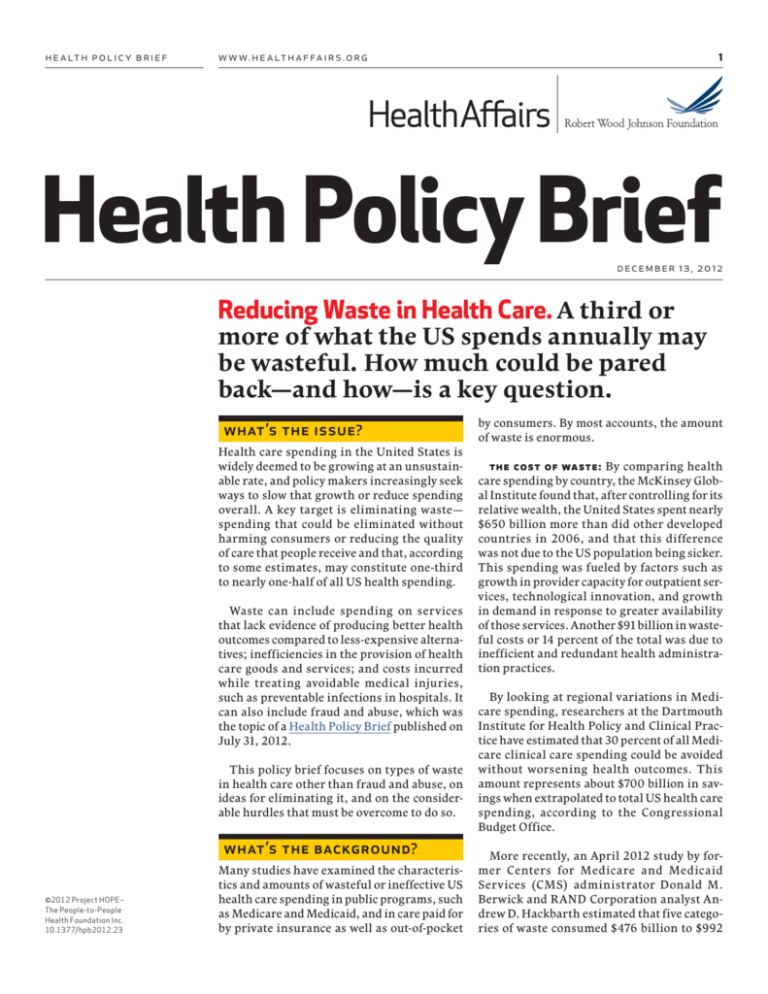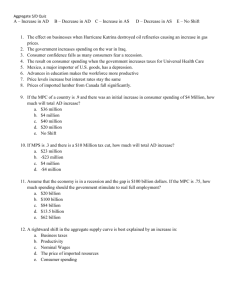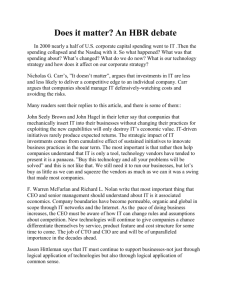
h e a lt h p o l ic y b r i e f
1
w w w. h e a lt h a f fa i r s .o r g
Health Policy Brief
d ec e m b e r 1 3 , 2 0 1 2
Reducing Waste in Health Care. A third or
more of what the US spends annually may
be wasteful. How much could be pared
back—and how—is a key question.
what’s the issue?
Health care spending in the United States is
widely deemed to be growing at an unsustainable rate, and policy makers increasingly seek
ways to slow that growth or reduce spending
overall. A key target is eliminating waste—
spending that could be eliminated without
harming consumers or reducing the quality
of care that people receive and that, according
to some estimates, may constitute one-third
to nearly one-half of all US health spending.
Waste can include spending on services
that lack evidence of producing better health
outcomes compared to less-expensive alternatives; inefficiencies in the provision of health
care goods and services; and costs incurred
while treating avoidable medical injuries,
such as preventable infections in hospitals. It
can also include fraud and abuse, which was
the topic of a Health Policy Brief published on
July 31, 2012.
This policy brief focuses on types of waste
in health care other than fraud and abuse, on
ideas for eliminating it, and on the considerable hurdles that must be overcome to do so.
what’s the background?
©2012 Project HOPE–
The People-to-People
Health Foundation Inc.
10.1377/hpb2012.23
Many studies have examined the characteristics and amounts of wasteful or ineffective US
health care spending in public programs, such
as Medicare and Medicaid, and in care paid for
by private insurance as well as out-of-pocket
by consumers. By most accounts, the amount
of waste is enormous.
the cost of waste: By comparing health
care spending by country, the McKinsey Global Institute found that, after controlling for its
relative wealth, the United States spent nearly
$650 billion more than did other developed
countries in 2006, and that this difference
was not due to the US population being sicker.
This spending was fueled by factors such as
growth in provider capacity for outpatient services, technological innovation, and growth
in demand in response to greater availability
of those services. Another $91 billion in wasteful costs or 14 percent of the total was due to
inefficient and redundant health administration practices.
By looking at regional variations in Medicare spending, researchers at the Dartmouth
Institute for Health Policy and Clinical Practice have estimated that 30 percent of all Medicare clinical care spending could be avoided
without worsening health outcomes. This
amount represents about $700 billion in savings when extrapolated to total US health care
spending, according to the Congressional
Budget Office.
More recently, an April 2012 study by former Centers for Medicare and Medicaid
Services (CMS) administrator Donald M.
Berwick and RAND Corporation analyst Andrew D. Hackbarth estimated that five categories of waste consumed $476 billion to $992
h e a lt h p o l i c y b r i e f
2
r e d u ci n g wa s t e i n h e a lt h c a r e
billion, or 18 percent to 37 percent of the
approximately $2.6 trillion annual total of
all health spending in 2011. Spending in the
Medicare and Medicaid programs, including
state and federal costs, contributed about onethird of this wasteful spending, or $166 billion
to $304 billion (Exhibit 1). Similarly, a panel
of the Institute of Medicine (IOM) estimated
in a September 2012 report that $690 billion
was wasted in US health care annually, not including fraud.
30%
Excess Medicare spending
According to the Dartmouth
Institute for Health Policy and
Clinical Practice, 30 percent
of all Medicare clinical care
spending is unnecessary or
harmful and could be avoided
without worsening health
outcomes.
categories of waste: Researchers have
identified a number of categories of waste in
health care, including the following:
• Failures of care delivery. This category
includes poor execution or lack of widespread
adoption of best practices, such as effective
preventive care practices or patient safety
best practices. Delivery failures can result in
patient injuries, worse clinical outcomes, and
higher costs.
A study led by University of Utah researcher
David C. Classen and published in the April
2011 issue of Health Affairs found that adverse
events occurred in one-third of hospital admissions. This proportion is in line with findings from a 2010 study by the Department of
Health and Human Services’ Office of Inspec-
exhibit 1
Estimates of Waste in US Health Care Spending in 2011, by Category
Cost to Medicare
and Medicaid a
Total cost to US
health care b
Low
Midpoint
High
Low
Midpoint
High
Failures of care delivery
$26
$36
$45
$102
$128
$154
Failures of care
%coordination
21
30
39
25
35
45
Overtreatment
67
77
87
158
192
226
Administrative complexity
16
36
56
107
248
389
Pricing failures
36
56
77
84
131
178
Subtotal (excluding
%fraud and abuse)
166
235
304
476
734
992
Percentage of total health
%care spending
6%
9%
11%
18%
27%
37%
Fraud and abuse
30
64
98
82
177
272
Total (including fraud
%and abuse)
197
300
402
558
910
1,263
21%
34%
47%
Percentage of total health
%care spending
source Donald M. Berwick and Andrew D. Hackbarth, “Eliminating Waste in US Health Care,” JAMA 307,
no. 14 (April 11, 2012):1513–6. Copyright © 2012 American Medical Association. All rights reserved.
notes Dollars in billions. Totals may not match the sum of components due to rounding. a Includes state
portion of Medicaid. bTotal US health care spending estimated at $2.687 trillion.
tor General (OIG), which found that Medicare
patients experienced injuries because of their
care in 27 percent of hospital admissions.
These injuries ranged from “temporary
harm events,” such as prolonged vomiting
and hypoglycemia, to more serious “adverse
events,” such as kidney failure because of medication error. Projected nationally, these types
of injuries—44 percent of which were found
to be clearly or likely preventable—led to an
estimated $4.4 billion in additional spending
by Medicare in 2009, the OIG found. Berwick
and Hackbarth estimate that failures of care
delivery accounted for $102 billion to $154 billion in wasteful spending in 2011.
• Failures of care coordination. These
problems occur when patients experience
care that is fragmented and disjointed—for
example, when the care of patients transitioning from one care setting to another is poorly
managed. These problems can include unnecessary hospital readmissions, avoidable complications, and declines in functional status,
especially for the chronically ill.
Nearly one-fifth of fee-for-service Medicare
beneficiaries discharged from the hospital
are readmitted with 30 days; three-quarters
of these readmissions—costing an estimated
$12 billion annually—are in categories of diagnoses that are potentially avoidable. Failures of care coordination can increase costs
by $25 billion to $45 billion annually. (See the
Health Policy Brief published on September
13, 2012, for more information on improving
care transitions.)
• Overtreatment. This category includes
care that is rooted in outmoded habits, that is
driven by providers’ preferences rather than
those of informed patients, that ignores scientific findings, or that is motivated by something other than provision of optimal care for
a patient. Overall, the category of overtreatment added between $158 billion and $226 billion in wasteful spending in 2011, according
to Berwick and Hackbarth.
An example of overtreatment is defensive
medicine, in which health care providers order
unnecessary tests or diagnostic procedures to
guard against liability in malpractice lawsuits.
A September 2010 Health Affairs study led by
Harvard University researcher Michelle M.
Mello estimated that in 2008, $55.6 billion
or 2.4 percent of total US health care spending was attributed to medical liability system
costs, including those for defensive medicine.
h e a lt h p o l i c y b r i e f
$690 billion
Waste in health care
A September 2012 Institute
of Medicine report estimated
that $690 billion was wasted
in US health care annually, not
including fraud.
Overtreatment can also result from overdiagnosis, which results from efforts to identify
and treat disease in its earliest stages when
the disease might never actually progress and
when a strategy such as watchful waiting may
have been preferred. For example, in July 2012
the US Preventive Services Task Force recommended against prostate-specific antigen–
based screening for prostate cancer because of
“substantial overdiagnosis” of tumors, many
of which are benign. Excessive treatment of
these tumors, including surgery, leads to unnecessary harms, the task force said.
Overtreatment also includes intensive care
at the end of a person’s life when alternative
care would have been preferred by the patient
and family, or excessive use of antibiotics.
Another form of overtreatment is the use of
higher-priced services that have negligible or
no health benefits over less-expensive alternatives. When two approaches offer identical
benefits but have very different costs, the case
for steering patients and providers to the less
costly alternative may be clear—for example,
using generics instead of brand-name drugs.
There is also provision of many services that
may once have been considered good health
care but that now have been discredited as
lacking in evidence of benefit. Under the
umbrella of the American Board of Internal
Medicine Foundation’s “Choosing Wisely” initiative, nine different medical specialty groups
and Consumer Reports have identified a series
of regularly used tests or procedures whose
use should be examined more closely. In 2013,
21 additional medical specialty groups will release similar lists in their respective fields.
“Although there
is general
agreement
about the types
and level of
waste in the
US health care
system, there
are significant
challenges
involved in
reducing it.”
3
r e d u ci n g wa s t e i n h e a lt h c a r e
The National Priorities Partnership program at the National Quality Forum, a nonprofit organization that works with providers,
consumer groups, and governments to establish and build consensus for specific health
care quality and efficiency measures, has
produced a list of specific clinical procedures,
tests, medications, and other services that
may not benefit patients. The next step is for
physicians and payers to change their practices accordingly.
After requesting public input, CMS on November 27, 2012, posted on its website a list of
procedures or services that may be overused,
misused, or provide only minimal health
care benefits. They include lap-band surgery
for obesity, endoscopy for gastroesophageal
reflux disease, and lung volume reduction
surgery. CMS said that these services may be
evaluated to determine whether they should
continue to be reimbursed under Medicare.
• Administrative complexity. This category of waste consists of excess spending
that occurs because private health insurance
companies, the government, or accreditation
agencies create inefficient or flawed rules and
overly bureaucratic procedures. For example,
a lack of standardized forms and procedures
can result in needlessly complex and timeconsuming billing work for physicians and
their staff.
In an August 2011 Health Affairs article, University of Toronto researcher Dante Morra
and coauthors compared administrative costs
incurred by small physician practices in the
United States, which interact with numerous
insurance plans, to small physician practices
in Canada, which interact with a single payer
agency. US physicians, on average, incurred
nearly four times more administrative costs
than did their Canadian counterparts. If US
physicians’ administrative costs were similar
to those of Canadian physicians, the result
would be $27.6 billion in savings annually.
Overall, administrative complexity added
$107 billion to $389 billion in wasteful spending in 2011.
• Pricing failures. This type of waste occurs when the price of a service exceeds that
found in a properly functioning market, which
would be equal to the actual cost of production
plus a reasonable profit. For example, Berwick
and Hackbarth note that magnetic resonance
imaging and computed tomography scans are
several times more expensive in the United
States than they are in other countries, attributing this to an absence of transparency
and lack of competitive markets. In total, they
estimate that these kinds of pricing failures
added $84 billion to $178 billion in wasteful
spending in 2011.
• Fraud and abuse. In addition to fake
medical bills and scams, this category includes the cost of additional inspections and
regulations to catch wrongdoing. Berwick
and Hackbarth estimate that fraud and abuse
added $82 billion to $272 billion to US health
care spending in 2011.
what are the issues?
Although there is general agreement about
the types and level of waste in the US health
care system, there are significant challenges
h e a lt h p o l i c y b r i e f
r e d u ci n g wa s t e i n h e a lt h c a r e
involved in reducing it. Much waste is driven
by the way US health care is organized, delivered, and paid for and, in particular, by the
economic incentives in the system that favor
volume over value. An additional problem is
that attacking “waste” usually means targeting someone’s income.
$389 billion
Waste because of
administrative complexity
Administrative complexity,
such as unnecessary forms and
paperwork, added up to
$389 billion in wasteful
spending in 2011.
In its September 2012 report, the IOM offered 10 broad recommendations for creating
a very different health care system in which research, new incentives, partnerships between
providers and patients, and a culture that supports continuous learning and development
could lead to real-time improvements in the
efficiency and effectiveness of US health care.
Although the IOM committee that prepared
the report did not estimate cost savings, it
predicted that implementing these measures
would improve care and reduce expenses.
The panel’s recommendations included the
following:
• Improve providers’ capacity to collect
and use digital data to advance science and
improve care.
• Involve patients and their families or
caregivers in care decisions. Increasing comparative effectiveness research may help physicians, patients, and their families make
more informed decisions. (See the Health
Policy Brief published on October 8, 2010, for
more information on comparative effectiveness research.)
• Use clinical practice guidelines and
provider decision support tools to a greater
extent.
“Much waste is
driven by the
way US health
care is organized,
delivered, and
paid for.”
• Promote partnerships and coordination
between providers and the community to improve care transitions.
• Realign financial incentives to promote continuous learning and the delivery
of high-quality, low-cost care. Numerous efforts are underway among public and private
payers to move from the traditional fee-forservice mechanism, which pays based on the
volume of services performed, and toward
those that pay based on value and outcomes.
(For more information, see the Health Policy
Brief published October 11, 2012, on pay-forperformance, and the Health Policy Brief published January 31, 2012, on accountable care
organizations.
4
• Improve transparency in provider performance, including quality, price, cost, and
outcomes information. In a May 2003 Health
Affairs article, Gerard F. Anderson from Johns
Hopkins University, Uwe E. Reinhardt from
Princeton University, and coauthors compared US health care spending with those of
other member nations of the Organization
for Economic Cooperation and Development.
They found that the United States spent more
on health care than any other country and that
the difference was caused mostly by higher
prices.
One way to improve transparency and reduce prices is through “reference pricing,”
in which an employer or insurer makes a defined contribution toward covering the cost
of a particular service and the patient pays
the remainder. The objective is to encourage
patients to choose providers with both quality and costs in mind. In a September 2012
Health Affairs article, University of California,
Berkeley, researchers James C. Robinson and
Kimberly MacPherson reviewed how this approach is being tested.
Many of the measures described above are in
process, although they are playing out at different rates in different regions and systems
around the country. There are widespread
concerns about how replicable and scalable
some new payment models are, and how soon
they will make a major difference in the way
care is provided and in what amount. There
are also cross-cutting trends, including consolidation of hospital systems and their employment of physicians, which could lead to
the provision of more unnecessary services,
not fewer.
For example, in a May 2012 Health Affairs article, Robert A. Berenson, an institute fellow
at the Urban Institute, and coauthors found
that dominant hospital systems and large
physician groups can often exert considerable
market power to obtain steep payment rates
from insurers.
fear of rationing: In theory, a focus on
eliminating waste in health care could skirt
the issue of rationing because wasteful activities, by definition, carry no benefit to consumers. However, there may be a fine line between
health care that is of no benefit and situations
where the benefits are relatively small, especially in comparison to the cost.
A common example involves continued chemotherapy treatments for patients having cer-
h e a lt h p o l i c y b r i e f
5
r e d u ci n g wa s t e i n h e a lt h c a r e
tain advanced cancers. These treatments can
cost tens of thousands of dollars but extend a
patient’s life by only a few weeks. However, restricting the use of such treatments or services
can lead to accusations of “rationing.”
To address many Americans’ fear that the
Affordable Care Act would lead to rationing,
the law specifically forbids the federal government from making decisions on “coverage, reimbursement, or incentive programs” under
Medicare that take cost-effectiveness into account, and “in a manner that treats extending
the life of an elderly, disabled, or terminally
ill individual as of lower value than extending the life of an individual who is younger,
nondisabled, or not terminally ill.” The law is
silent on any of these activities going on outside of Medicare.
what’s next?
Efforts to extract waste from the health care
system will in all likelihood continue along
a range of federal government initiatives,
including information technology adoption,
pay-for-performance, payment and delivery
reforms, comparative effectiveness research,
and competitive bidding. Similar programs
are also being initiated by state Medicaid
agencies and by private payers. In the view of
many experts, even more vigorous efforts to
pursue the reduction of waste in health care
are clearly warranted. ■
About Health Policy Briefs
Written by
Nicole Cafarella Lallemand
Research Associate
Urban Institute
Editorial review by
Andrew D. Hackbarth
Assistant Policy Analyst
RAND Corporation
Brent C. James
Executive Director
Institute for Health Care Delivery
Research
Intermountain Healthcare
Bob Kelley
Senior Vice President
Truven Health Analytics
Ted Agres
Senior Editor for Special Content
Health Affairs
Susan Dentzer
Editor-in-Chief
Health Affairs
Health Policy Briefs are produced
under a partnership of Health Affairs
and the Robert Wood Johnson
Foundation.
Cite as:
“Health Policy Brief: Reducing Waste
in Health Care,” Health Affairs,
December 13, 2012.
Sign up for free policy briefs at:
www.healthaffairs.org/
healthpolicybriefs
resources
Anderson, Gerard F., Uwe E. Reinhardt, Peter S.
Hussey, and Varduhi Petrosyan, “It’s the Prices, Stupid: Why the United States Is So Different from Other
Countries,” Health Affairs 22, no. 3 (2003): 89–105.
Bentley, Tanya G.K., Rachel M. Effros, Kartika
Palar, and Emmett B. Keeler, “Waste in the US Health
Care System: A Conceptual Framework,” Milbank
Quarterly 86, no. 4 (2008): 629–59.
Berenson, Robert A., Paul B. Ginsburg, Jon B.
Christianson, and Tracy Yee, “The Growing Power of
Some Providers to Win Steep Payment Increases from
Insurers Suggests Policy Remedies May Be Needed,”
Health Affairs 31, no. 5 (2012): 973–81.
Berwick, Donald M., and Andrew D. Hackbarth,
“Eliminating Waste in US Health Care,” JAMA 307,
no. 14 (April 11, 2012): 1513–6.
Classen, David C., Roger Resar, Frances Griffin,
Frank Federico, Terri Frankel, Nancy Kimmel, et al.,
“‘Global Trigger Tool’ Shows That Adverse Events in
Hospitals May Be Ten Times Greater Than Previously
Measured,” Health Affairs 30, no. 4 (2011): 581–9.
Elmendorf, Douglas W., “Options for Controlling the
Costs and Increasing the Efficiency of Health Care,”
Statement before the Subcommittee on Health, Committee on Energy and Commerce, US House of Representatives, March 10, 2009.
Farrell, Diana, Eric Jensen, Bob Kocher, Nick
Lovegrove, Fareed Melhem, Lenny Mendonca, et al.,
“Accounting for the Cost of US Health Care: A New
Look at Why Americans Spend More,” McKinsey
Global Institute, December 2008.
Hoffman, Ari, and Steven D. Pearson, “‘Marginal
Medicine’: Targeting Comparative Effectiveness
Research to Reduce Waste,” Health Affairs 28, no. 4
(2009): w710–18. DOI: 10.1377/hlthaff.28.4.w710.
Institute of Medicine, “Best Care at Lower Cost: The
Path to Continuously Learning Health Care in America,” September 6, 2012.
Kelley, Robert, “Where Can $700 Billion in Waste
Be Cut Annually from the US Healthcare System?”
Thomson Reuters, October 2009.
Levinson, Daniel R., “Adverse Events in Hospitals:
National Incidence among Medicare Beneficiaries,”
Department of Health and Human Services Office of
Inspector General, November 2010.
Morra, Dante, Sean Nicholson, Wendy Levinson,
David N. Gans, Terry Hammons, and Lawrence P.
Casalino, “US Physician Practices Versus Canadians:
Spending Nearly Four Times as Much Money Interacting with Payers,” Health Affairs 30, no. 8 (2011):
1443–50.








